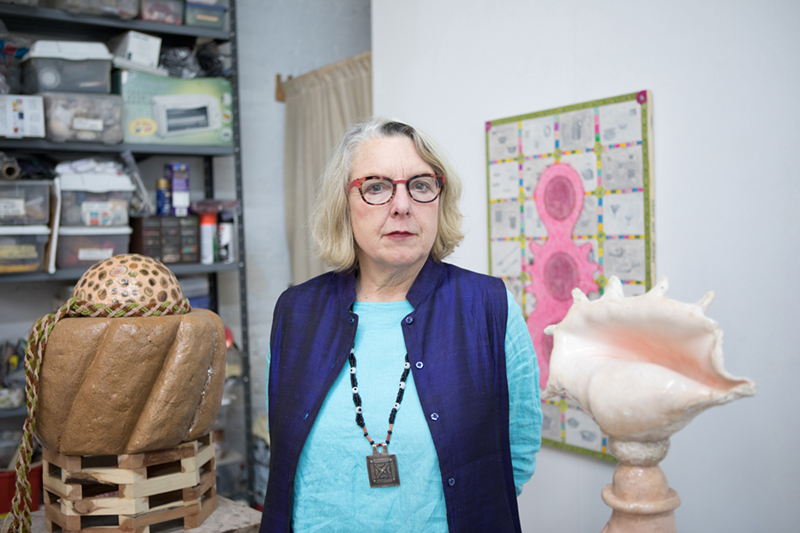
Nancy Bowen in her studio in the Brooklyn Navy Yard. © 2018 by Susan Silas
CHRYSANNE:
I found it interesting that as a student at the School of the Art Institute of Chicago you had visiting artists and curators, such as Ree Morton and Marcia Tucker. I remember Ree Morton’s work very well because one of her exhibitions came to the Albright Knox Art Gallery in Buffalo. She had a very eclectic, almost humorous way of making work and sadly, she died very young. I was wondering how you would describe your experience having these two accomplished women as mentors because a lot of female art students during that time only had male visiting artists, or visiting curators. What was the effect of having two women like Ree Morton and Marcia Tucker to have discussions with?
NANCY:
It was really, really important and pretty life changing. SAIC at that time had eleven sculpture professors and ten of them were men. The one woman was about 80 years old. The visiting artist series brought in Ree Morton, Marcia Tucker, Barbara Kruger, Joyce Kozloff and other women artists. Whoever was in charge of it was really involved with feminist artists. We women students all became feminists. I was friends with a group of women who became very politicized and we worked really hard to get some teaching positions for women in the sculpture department. By the time I left, there were two women who had full time jobs there.
In terms of my own work it was so important. I was making sculpture that was based on the body. I also had discovered Louise Bourgeois. While I was in school, I worked for the Video Data Bank, which was run by two women, Lyn Blumenthal and Kate Horsfield. It was one of the first instances of artists interviewing artists on videotape and it has now became an important archive. Rob Storr and I were their first employees and so we got to go with them when they interviewed artists. I got to come to New York and stay in their lofts and I met Pat Steir and Louise Bourgeois and Martha Rosler and all these amazing women artists. This was back in the day when you could call up an artist and say: “Could I come over and get slides for the Video Data Bank in Chicago?” And they’d say, “Sure.”
I took that knowledge and inspiration into my earliest work, which was very much involved with the female body, and asking questions about its representation. I was a student, so I was a sponge and stealing from everybody. But from Ree Morton I really got a sense of mixed media, of play, of color, and the old adage: “The personal is political.”
From Marcia Tucker I got sort of a different thing. SAIC at that time was pretty anti-intellectual. Marcia came for three weeks and taught a seminar. It must have been in the summer because I took a class with her that met every morning for three weeks. We had to read six books and I still remember most of what we read: The Poetics of Space, The Denial of Death, Mythologies, and such. It was so great to have someone push us to think about how research could influence our work. We weren’t making conceptual work by any means. Marcia was also great in terms of support back in the day. She was like: “When you move to New York call me up.” I did, and kept up a friendship for a number of years.
CHRYSANNE:
I came across the term “eccentric abstraction” used by Lucy Lippard in reference to Ree Morton’s work. In looking at your sculptures, I thought that was so interesting. I was wondering how you felt about the terminology “eccentric abstraction” and if that connects with you?
NANCY:
Yes, that resonates with me. I was totally inspired by Brancusi as well as Eve Hesse but I would never have thought about making something so pure. For me it was always important to bring in an element of humor, or the grotesque, or the excessively decorative, and maybe that’s where the eccentric part comes in. The other early influence I had studying in Chicago was outsider art. I had several teachers who were collectors of outsider art. And I had a sculpture teacher, Jim Zanzi, who took us on trips to meet outsider architects and sculptors who lived in Northern Wisconsin, and what I got from them was this idea that you could use any kind of material, whatever was around. And also most of them were involved with very repetitive and obsessive work. Even though often it was just cement and broken glass, there was an idea about using pattern as decoration no matter what the material was. Influenced by that, I think my work at the time and even now could definitely be seen as eccentric abstraction.
SUSAN:
In the beginning, with your earliest work, you were doing representational figuration. At what point and with what prompting did the break come between something that was definitively representational and something much more abstract?
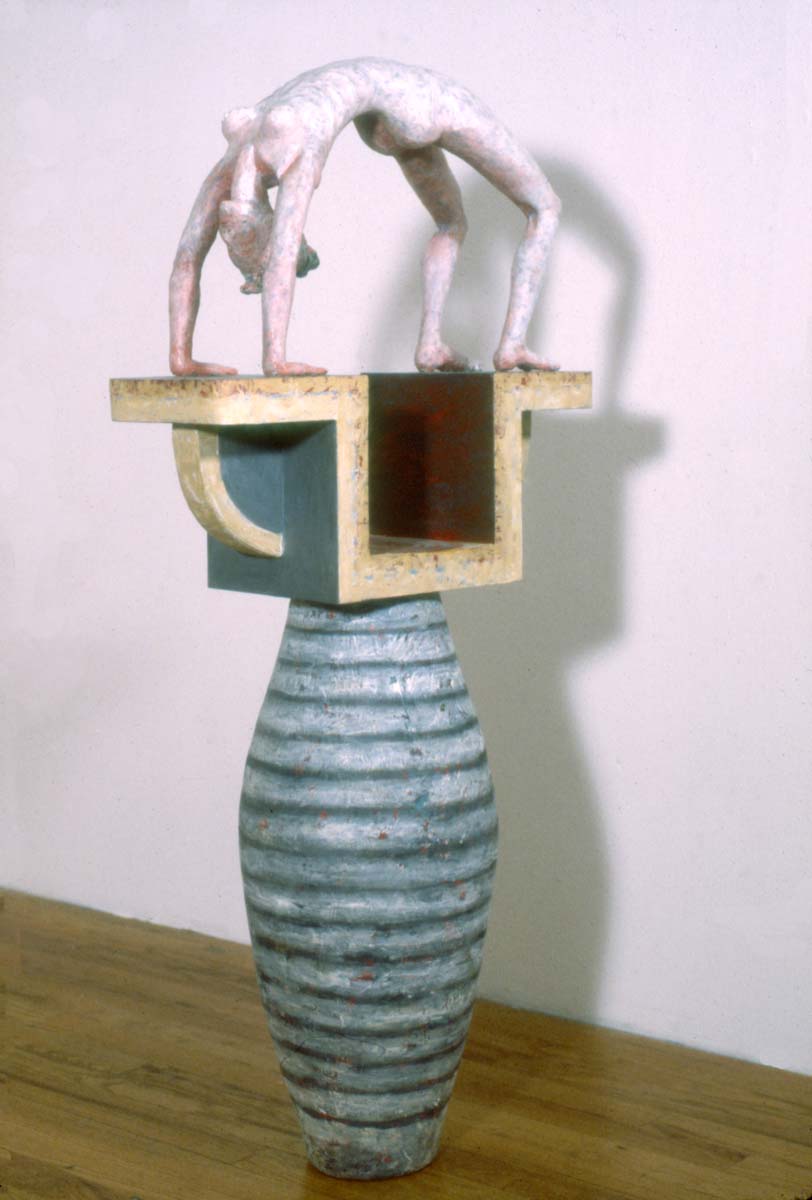
The Wheel, 1983
NANCY:
In the early 80s I was making representational sculptures of women in extreme poses, trying to posit them as outside of the male gaze. But by the mid 80s, when the feminist movement got divided into those who saw woman as a social construct and those who saw it as an embodied state, I stopped making that work. Artists like Barbara Kruger, Cindy Sherman, Laurie Simmons, and a lot of people using photography were looking at the way femininity was constructed rather than embodied. My work fell on the embodied side and there was a sense that that was not a smart approach. I felt discouraged by the response to my work, and there was a point where I literally stopped making work for almost a year. I started reading all the French theorists: Cixous, Irigary, Kristeva, just trying to figure out how to situate myself in this whole big question of the female body. Frankly, I was not secure enough in my own voice to just say: “Fuck it, I’m just going to just keep doing what I’m doing.” But I felt very strongly that if women didn’t try to represent the female body from a female perspective, we were contributing to a censorship of women.
I really felt like I was doing something that was kind of wrong. What happened? For almost ten years I did all this work where I was taking the body apart and thinking about the inside, what it felt like to inhabit a female body, as opposed to what it might look like. Actually before I went to art school I had gone to a liberal arts school, and I started out my education as a pre-med student. I was really interested in science and the body, so it was natural for me to look inside. I did a lot of pieces where I was making abstractions of the brain and endocrine systems, but I would create the endocrine systems out of beadwork. I used the beadwork to refer to crafts that were thought of as “women’s work”. I tried to address gender through the materials of the sculpture.
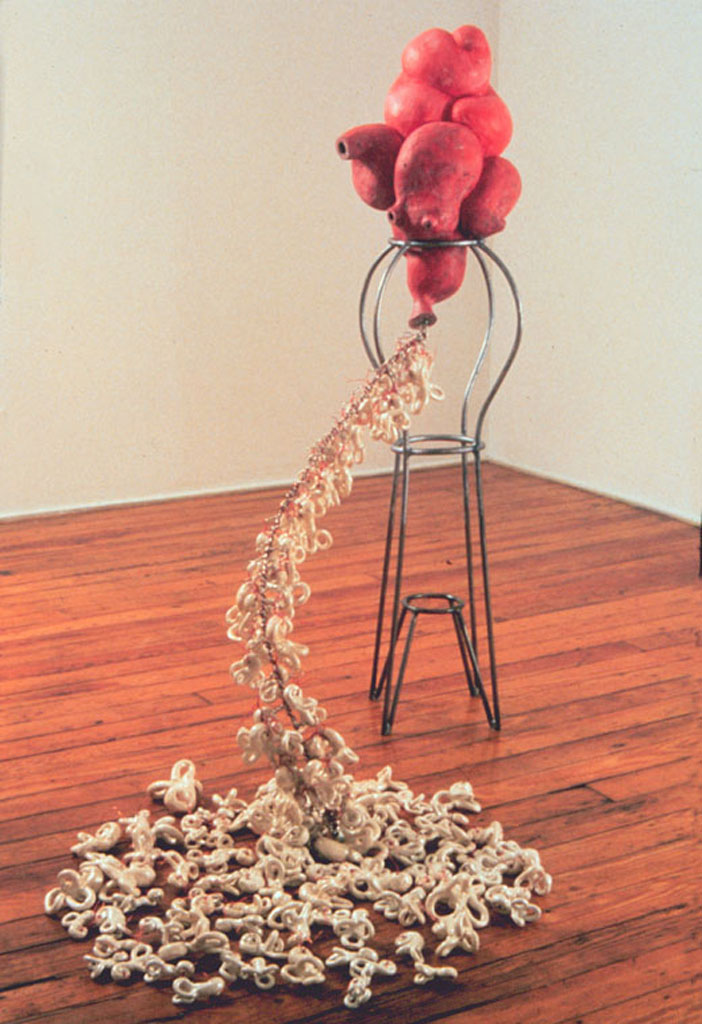
Aural Obsession, 1993
CHRYSANNE:
Is that when you went to Stanford?
NANCY:
Yes, but that’s not when I was making that work. That’s where I was a pre-med student for all of one semester. I felt that this was somebody else’s idea of what I was supposed to be, not mine, and so I dropped out and transferred to SAIC. For a long time I was making abstracted anatomical constructions using glass and clay and decorative techniques like beading. I was weaving beadwork and making pieces that riffed on the idea of being human or being corporal. Often times I would alter the scale and make things that looked like large jewelry but were really different systems of the interior of the body.
CHRYSANNE:
I’m very interested that you have called yourself an archaeologist in an artist statement I read. I was recently in Greece, and I did a project I called “home archaeology” where I took apart my ancestral home in Athens. The idea of the archaeology is evident looking at your work, an archaeology of the ornament, or the tantric, or the Buddhist: these different configurations that are so universal. What are your thoughts about deconstructing ornament and then re-ornamenting?

Mind Over Matter, 1997
NANCY:
I do call myself an “artistic archeologist” scavaging ornament from other cultures. There are two different aspects to your question that interest me. One is that I see things in ornament from one culture that are echoed in ornament from another culture, and that really excites me. I see ornament as a way to bridge gaps betweens cultures, in a metaphorical sense. It is a way to posit an optimistic mingling of cultures that might not exist in real life. For instance, in this drawing, Pink Venus, I have Islamic ornament next to Buddhist ornament surrounding early American gravestone imagery. And there is something about all of the imagery that visually resonates with each other. Not just that I put them on one piece of paper, but they all are having a conversation with each other.
I remember in the 90s there was this sort of edict against appropriating images from other cultures. It was seen as a colonialist attitude. But I feel that so much ornament is out there and if I’m using it respectfully and asking it to coexist with ornament from another culture or from my New England heritage, I find the mash up really interesting. It always ends up creating something that doesn’t exist anywhere. And since I am also thinking about gender, it’s like a third gender. I just like the possibilities of the image making that can occur; that all of these fragments of ornament come from different systems of information. I’m really interested in the idea of belief systems and how we humans understand the world. I’m interested in spirituality as a belief system with various kinds of iconography. I mean you see here I’m using tantric images and I’ve got Hindu, Islamic and Buddhist imagery. I use different fragments to denote different ways of thinking about the same thing.

Pink Venus, 2017
CHRYSANNE:
Many of my Indian artist friends have used constructs of contemporary Western art along with ancient Greek mythology in their work. I don’t have a problem with cultural appropriation.
SUSAN:
On your site there was a quote by someone named Oleg Grabar. He says the mediation of ornament as an agent is not logically necessary, but without it understanding is more difficult. That reminded me of a book I read in my twenties by a guy named Morse Peckham called Man’s Rage for Chaos: Biology, Behavior and the Arts. For him, what defines an object as art is an added but unnecessary element; what he called “non-functional stylistic dynamism” or something that had no utility per se. Grabar is saying something close but he says the ornament does have a function, and that function is to aid understanding even if it isn’t a logical necessity. So they reminded me of each other although they’re not saying the exact same thing.
It also made me wonder what you feel the relationship between ornament and beauty is, because I feel beauty has a function. Do you think they’re synonymous, or do you think they’re actually different things?
NANCY:
That’s a good question. I don’t think they’re synonymous. I think ornament works in the service of beauty, but I don’t think all ornament is necessarily beautiful. I do think that taste is involved, in that you might find some ornament really beautiful that I don’t. So it’s up to the viewer, but I think that ornament is generally made with an eye towards beautifying something, whether it’s architecture or functional ware or artwork.
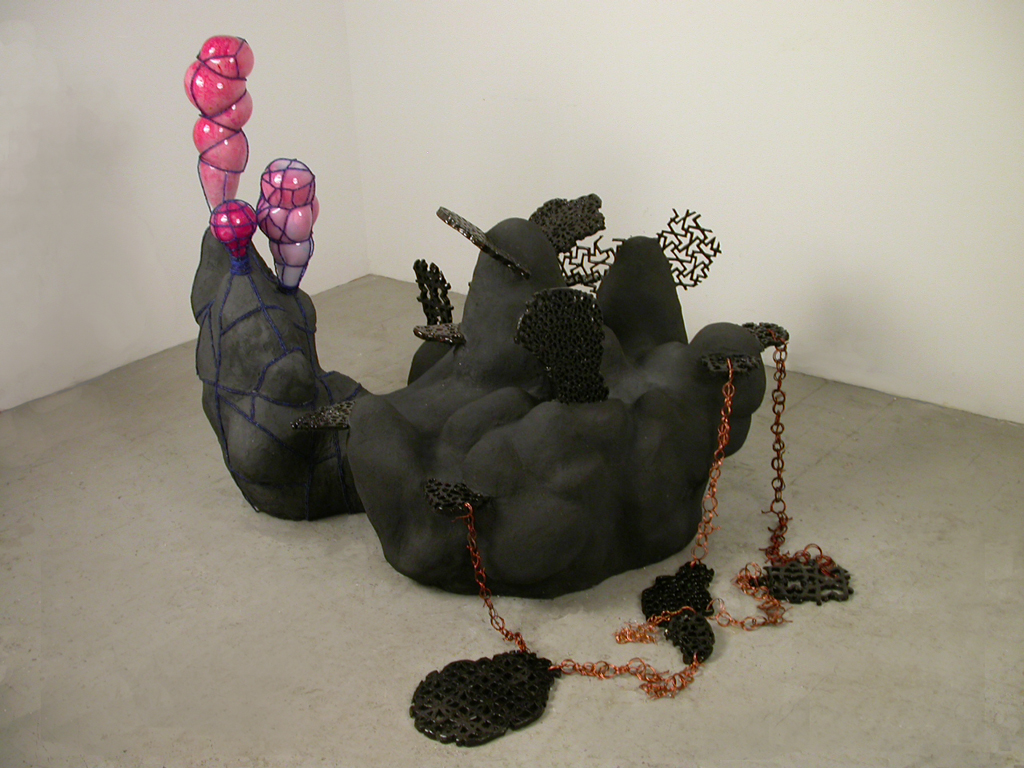
Burden, 2009
SUSAN:
Do you think when Grabar talks about ornament enabling understanding, that it is actually being drawn in by beauty that enables understanding, or is it something else?
NANCY:
I think that’s what he is trying to get at. He more or less says that people use ornament for the love of making it, and for the pleasure of the viewer. I mean he’s written this 200-page book, The Mediation of Ornament, examining ornament in architecture, geometry, nature and writing, with a visually acute analysis of how ornament functions in these different situations. Then he posits that basically the use of ornament has to do with love. And I agree with him about that. It seems like a very optimistic approach to art making!
CHRYSANNE:
A lot of ornamentation uses a patterning or mirroring quality in order to enhance the ornament. Do you use that or how would you relate to that?
NANCY:
By instinct I tend to work with bilateral symmetry, I think because I’m in a body. That’s something, on a formal level, that has dogged me forever. But in my sculptures, symmetry serves a purpose, it makes them feel like bodies even when they are made of parts not associated with the body. It works subliminally.
SUSAN:
I was going to say that I do see that in everything in your studio; a sense of symmetry. And related to that, I see mirroring as well.
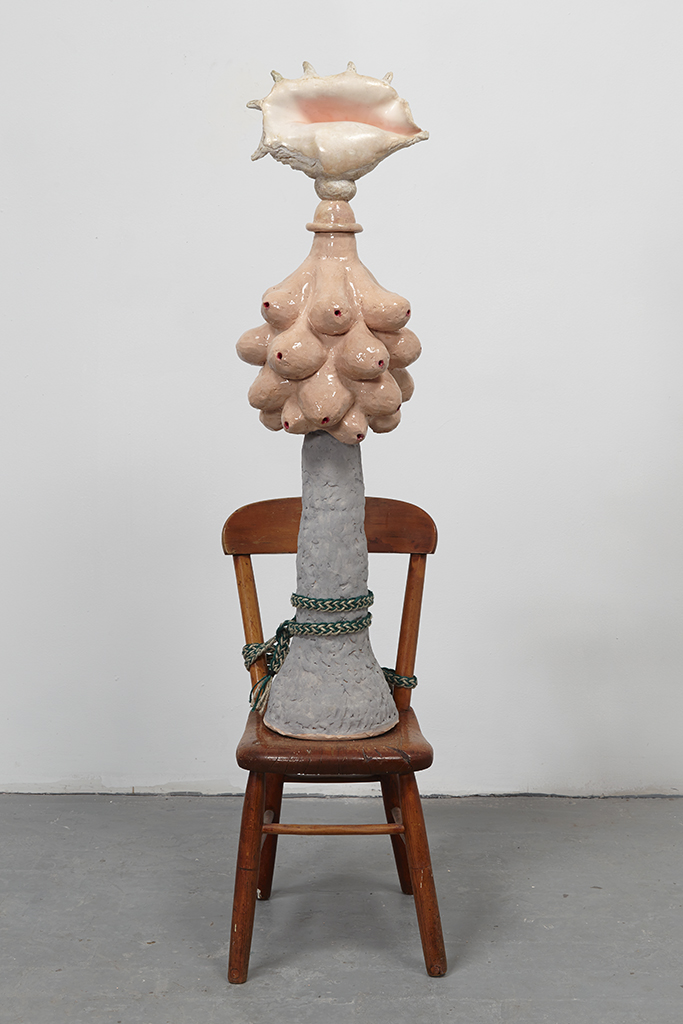
Artemis Dilemma, 2016
NANCY:
I mean if you look at that sculpture, Artemis Dilemma, you could divide it more or less in half and it’s not quite symmetrical but appears as if it is. These recent sculptures are part of a series of totems that I made in the past few years. A totem is usually a phallic form and so I decided to embed female imagery into the overall form to confuse the situation a bit. They don’t look like bodies but they are more or less my height because I tend to relate to my sculpture in terms of my body.
SUSAN:
This may be a good moment to segue into the topic of politics, specifically the politics of what goes on in art schools and the dynamic of power in these institutions. The recent women’s marches obviously enhance the visibility of women; the sea of pink hats is all about that. You were exceptionally lucky to have had some great women come to school when you were a student. I actually did too, but they were always visiting artists. They were never ever regular faculty. Sherrie Levine came, and Barbara Kruger came, and Barbara Bloom came, but they were never offered permanent jobs. I think a few of them wanted to stay but a faculty position wasn’t on offer.
As I get older and see the longer view, I see the degree to which women are consistently undervalued in the art world. The reason is simple. Men make the decisions and they get to decide who and what will have value. It’s not as if we don’t all know this by now, but over time it feels more egregious. Your experience at Columbia, which you recently wrote up in a Facebook post, struck me as an example of the way in which this undervaluation manifests itself in multiple ways to undermine women and elevate men.
That Columbia knowingly hired someone, Tom Roma, who had lost a previous job due to his sexual harassment of students already shows a clear disregard for the young women who would inevitably come into contact with him. That in the end, you were judged by this man of all people, who sat on your review committee, and who knew that you had objected to his hiring because he was a sexual predator, strikes me as completely outrageous. So I wondered if you could talk a bit about that experience, especially given the current focus on abusive men in power, so central in the past year.

Pink Future Fiction, 2017
NANCY:
It’s interesting because that was not a good time for me, so I had put it to bed and had forgotten about it, until all the #me too started.
CHRYSANNE:
When did you first start teaching at Columbia?
NANCY:
I was hired to teach there in 1994. They were starting a new MFA program. I was hired along with Jon Kessler, Gregory Amenoff, and Archie Rand. And well, the whole Tom Roma thing….
SUSAN:
I think you should explain it briefly so that we have some background.
NANCY:
Basically what happened was that somebody offered to give Columbia a chunk of money to start a photo area and the money came with the photographer Tom Roma attached to it. Our then chair, Alan Hacklin, asked if anybody knew anything about him. I had never heard of him, but I had several friends who were photographers so I asked around. People said: “Oh my goodness, you know he got let go from Yale for sexually harassing students.” So I went to the chair and told him what I had heard. I said: “Why would we want to hire someone who’s a known predator.” But they hired him. There was no search. I don’t think you could even do that now. There were only two women in the department, myself and Reeva Potoff. The culture in the department was pretty macho.
Some time during the next year Tom Roma came up to me and said: “ I hear you don’t want me to be here.” I asked what he was talking about? He said: “Alan told me what you said about me and that you didn’t want me here” But we had to work together. We did, and it was a crazy situation. There was a lot of faculty fraternizing with students. At my job before Columbia, I was sitting in a faculty meeting, of mostly men, and I realized that every man in the room was married to or dating somebody who had been or was a student. That was how things went back then.
Anyway, fast-forward. Two students came to me and told me they had been sexually accosted by Tom Roma and they didn’t know what to do. I didn’t know what to do, but I looked in the faculty handbook, and figured it out. I took them to the then chair, no longer Alan Hacklin, but Ronald Jones. I was told by him that I had done my duty and to stay out of it, and I did, because it was a legal thing. So I don’t know what happened to those two students. Neither of the two students I helped were among the students written about recently in the New York Times.
When we were going through all of this I kept really good notes about what was going on. I found the notes when the reporters from Buzz Feed first approached me. I also had the letters I had written to the university for various aspects of my appeal, which I will tell you about. When my review came up, Tom Roma was the one chosen to represent the art department. I was senior to him so that’s not even normal, having somebody junior to you be the one person who is representing the department. My committee was him, Benjamin Buchloh and somebody from the math department who was chosen because he liked art. Really?
CHRYSANNE:
Who chose them?
video ©2018 by MOMMY
NANCY:
Someone, a higher up. It wasn’t Ron Jones, it was somebody higher up than him. Our department was in a crisis because no one trusted Ron so I believe that the Provost may have put the committee together. But at any rate I didn’t pass that review and….
SUSAN:
And that was a tenure review, correct?
NANCY:
Pre-tenure. It was an up or out review. I didn’t pass it. I appealed it on the grounds that I was being judged by all men and one of them had a reason to not want me there. Because it’s a private university the review process is kept secret, but all these guys could not keep their mouths shut. So I was hearing all this stuff and somebody told me that Tom Roma would be representing the art department. I appealed on the grounds that I was making feminist work, and that I was a sculptor. He was a documentary photographer and he didn’t really participate in the contemporary art world. The fact that he was deciding about me… it just seemed like he wouldn’t be doing a very good job, and the rest of the people on the committee were men. So when I appealed, the university formed a committee that was going to adjudicate this problem and when I met with that committee, they were all men. One of them was from the law school. So they wrote a report, and authorized a new review on the grounds that we just discussed. The school did do the right thing. But they did it in secret. They sent out my review package to four women. I don’t know who they were. Then the vice president of the university, who was a man and not in the arts, read their letters and sent me a letter that quoted from their letters and I didn’t pass that review either. That was the end of my experience there.
CHRYSANNE:
Do you have their letters, the women’s letters?
NANCY:
No I was never allowed to see them. An artist I know told me later that she wrote a letter for me and she sent me her letter and her letter was really good. I don’t know what happened. To come back to what’s going on now, this kind of review process isn’t happening in schools because there are all kinds of procedures and rules.
And the way it was set up for students then, there was no safe place to make a complaint. The process then was to take the student to the chair, and if the chair is a man who is sleeping with students, how seriously is that man going to take this problem? I think in the past that was how it was in many schools. The people who were in place to help you weren’t necessarily going to be very helpful because they were part of the problem.
SUSAN:
I am not sure that has changed much because the system is still geared to protecting the school as an institution over the individuals who suffer any kind of abuse within the system.
NANCY:
You’re absolutely right.
SUSAN:
Interestingly, The New Yorker just this last issue had a long piece called “safer spaces” that was about a study initiated at Columbia around the time of the Emma Sulkowicz protest, in which they purport to look at the conditions that foster unwanted sexual contact between students in an attempt to try to figure out ways to mitigate this. The protest by Emma Sulkowicz was directed at the school, in its response to unwanted sexual contact between herself and another student. Nothing in this study, as far as I could tell, (I read the article and not the study itself), says a peep about the power dynamic between male and female faculty or the relationship between faculty and students. Male faculty outnumber female faculty in most departments, and the value put on male work is often greater. It seemed to me that a really important aspect of what these “conditions” are wasn’t even being commented on. If the study was not looking at what goes on among the faculty, who are the mentors and the teachers of the students, and if that’s a problematic area, then are they really looking at the conditions that lead to unwanted sexual contact? And of course, I am sure there are faculty still sleeping with their students.
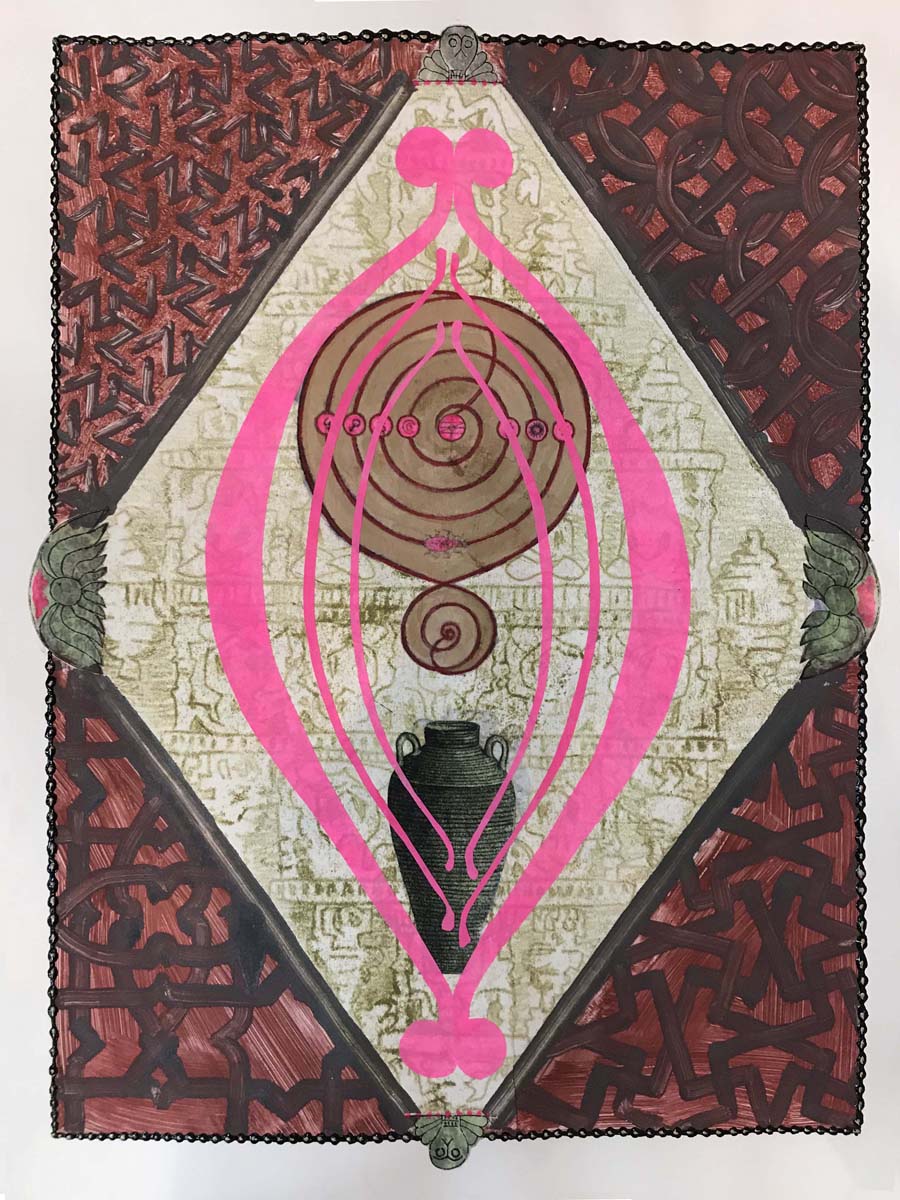
Pink Veil, 2017
NANCY:
I’m sure there are. I happen to have a friend who teaches at Columbia, in the School of the Arts, and he told me that the very first faculty meeting of this semester the first thing that came up was the Tom Roma resignation. The dean, Carol Becker, is pretty great and she’s a big feminist. They evidently made a resolution that the faculty, in the School of the Arts, cannot have any kind of sexual relationships with students, even graduate students. In the rest of the university, faculty can have consensual sexual relationships with graduate students, just so long as they’re not their graduate student. The art department, of all of the arts, took a more puritanical approach.
If I think back to the students who were being sexually harassed by Tom Roma, he isolated those students and was like; “I can help you, I’m the only one who can help you. I can introduce you to these curators or whatever.” The female students believed it. One of these students barely ever spoke to me when I was on the faculty there, and the fact is, I would have been a way more appropriate mentor to her than he was.
I still teach, and I take the idea of being a role model really seriously — being an ethical role model, and really empowering young women to go out and be sculptors. When I was going to school there weren’t many women in the sculpture department and to get respect in the department I really had to carry a hundred pound bag of plaster on my shoulder and wear work boots. I had to be strong and tough. It’s funny to me now, but that was the way to prove myself.
SUSAN:
How long did it take for you to land on your feet after the incredible disappointment of what happened at Colombia?
NANCY:
I was really lucky. I had a one year job filling in for somebody at RISD and another person at Mass Art. The following year there was a full time position at Purchase. I applied for the job and got it.
SUSAN:
Wow it was fast.
NANCY:
Yes, it was fairly fast. But it was pretty devastating because it was very public and also because my ego had bought into teaching in the Ivy League and I was very identified with my job. What I saw when I was going through all of my correspondance from that time was, that I was really doing a lot there. I have all these letters from the chair and the dean thanking me for this, that and the other thing. “Oh thank you, but you’re fired”, or rather “you’re not being rehired”. Yes, it was pretty upsetting. Going from Columbia to a state school, I took a big pay cut. So over the long haul it affected my financial situation quite a bit. I was also living in Columbia housing, so I lost my job and my apartment. That’s when I moved to Greenpoint. I got lucky there. I was able to find a place.

Nancy Bowen with red star fish. © 2018 by Chrysanne Stathacos
